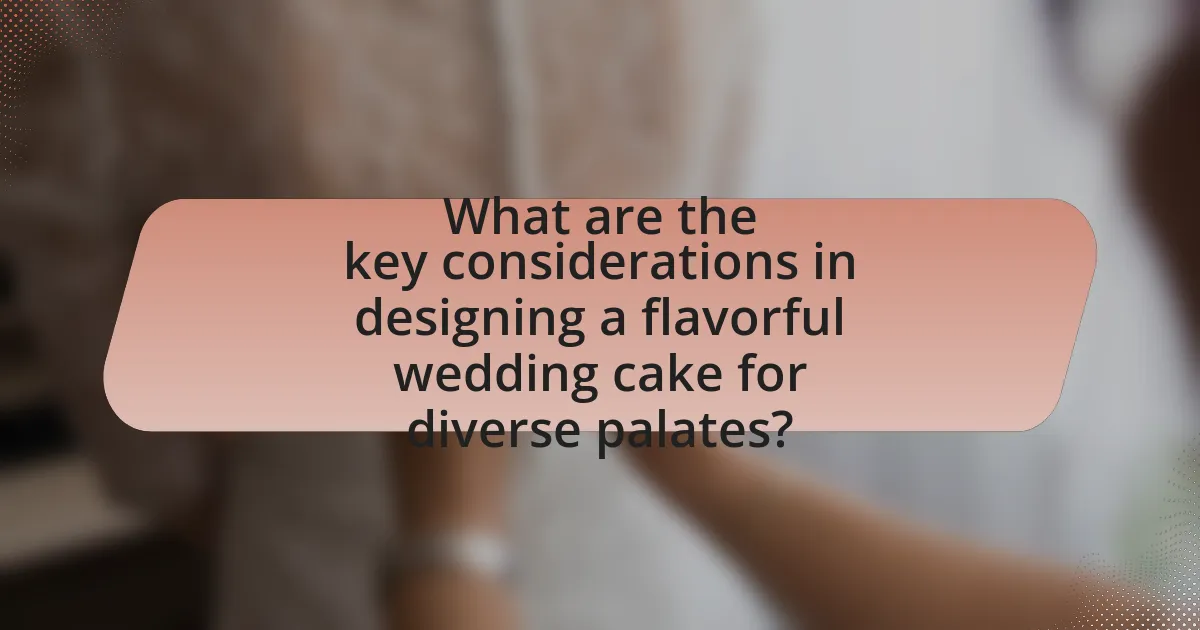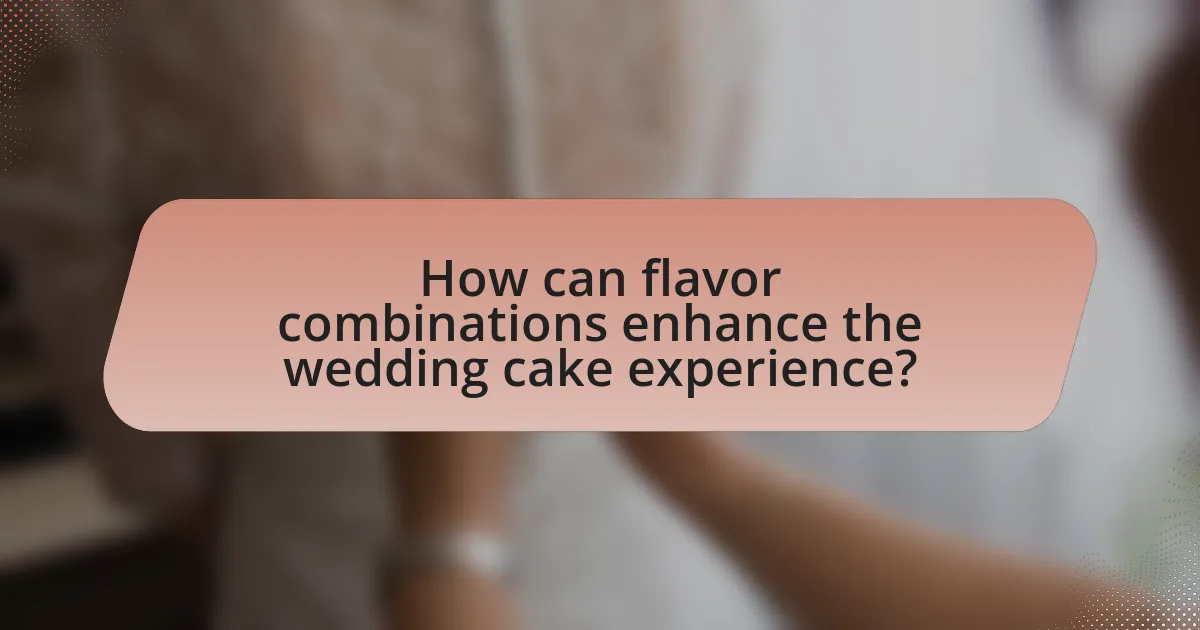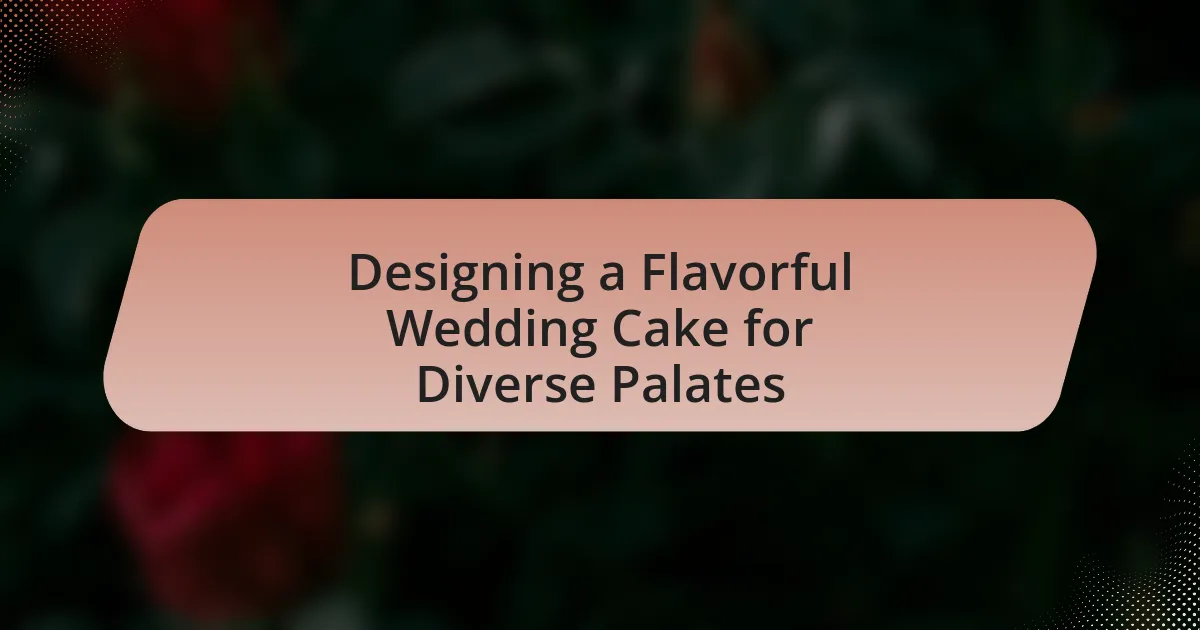The article focuses on designing a flavorful wedding cake that caters to diverse palates, emphasizing key considerations such as flavor variety, dietary restrictions, and balance in sweetness and texture. It explores how cultural influences shape flavor preferences, highlighting popular flavors across different cultures and the significance of seasonal ingredients. Additionally, the article discusses best practices for accommodating dietary needs, including gluten-free and vegan options, and offers insights into innovative flavor pairings and the importance of texture in enhancing flavor perception. Finally, it provides practical tips for couples on selecting flavors and ensuring a successful cake tasting experience.

What are the key considerations in designing a flavorful wedding cake for diverse palates?
Key considerations in designing a flavorful wedding cake for diverse palates include selecting a variety of flavors, accommodating dietary restrictions, and ensuring balance in sweetness and texture. Offering multiple flavor options, such as chocolate, vanilla, and fruit-infused varieties, caters to different preferences. Additionally, incorporating gluten-free, dairy-free, or vegan options addresses dietary needs, as approximately 30% of people have food allergies or intolerances. Balancing sweetness with complementary flavors, such as citrus or spices, enhances the overall taste experience, making the cake appealing to a broader audience.
How do flavor preferences vary among different cultures?
Flavor preferences vary significantly among different cultures due to historical, geographical, and social influences. For instance, in Asian cultures, flavors such as umami and sweet-sour combinations are prevalent, reflecting the use of ingredients like soy sauce and tamarind. In contrast, Mediterranean cuisines often emphasize olive oil, herbs, and fresh vegetables, leading to a preference for savory and aromatic flavors. Additionally, research indicates that cultural background shapes taste perception; a study published in the journal “Appetite” by authors like Yeomans and Blundell found that individuals from different cultural backgrounds have distinct taste sensitivities and preferences, which can influence their food choices and flavor combinations.
What are some popular flavors in traditional wedding cakes across cultures?
Popular flavors in traditional wedding cakes across cultures include vanilla, chocolate, fruit, and almond. Vanilla is widely favored in Western cultures, often paired with buttercream frosting. Chocolate is also popular, especially in modern weddings, providing a rich alternative. In many Asian cultures, fruit flavors such as mango or coconut are common, reflecting local tastes. Almond flavor is prevalent in Mediterranean wedding cakes, particularly in Italian and Greek traditions, where it is often combined with marzipan. These flavors are chosen not only for their taste but also for their cultural significance, enhancing the celebratory nature of weddings.
How can cultural influences shape flavor choices for wedding cakes?
Cultural influences significantly shape flavor choices for wedding cakes by reflecting traditional tastes and ingredients unique to specific regions or communities. For instance, in Italian weddings, flavors like ricotta and almond are popular, while in Indian weddings, flavors such as cardamom and saffron are often favored. These preferences stem from historical culinary practices and the symbolic meanings associated with certain flavors in various cultures. Additionally, cultural celebrations often dictate the incorporation of local fruits, spices, and sweets, which further diversifies the flavor profiles of wedding cakes. This connection between culture and flavor choice is evident in the increasing trend of fusion cakes, where traditional flavors are blended with modern techniques to cater to diverse palates.
What dietary restrictions should be considered when designing a wedding cake?
When designing a wedding cake, dietary restrictions such as gluten intolerance, nut allergies, dairy allergies, and vegan preferences should be considered. Gluten intolerance affects approximately 1% of the population, necessitating gluten-free flour alternatives like almond or coconut flour. Nut allergies, which impact about 1-2% of individuals, require careful ingredient selection to avoid cross-contamination. Dairy allergies, affecting around 2-3% of people, can be addressed by using non-dairy substitutes like almond milk or coconut cream. Additionally, vegan diets, chosen by approximately 3% of the population, necessitate the exclusion of all animal products, prompting the use of plant-based ingredients. These considerations ensure that the wedding cake accommodates the diverse dietary needs of guests.
How can gluten-free options be incorporated into wedding cake designs?
Gluten-free options can be incorporated into wedding cake designs by using alternative flours such as almond, coconut, or rice flour, which provide structure and flavor without gluten. These flours can be blended with gluten-free starches like tapioca or potato starch to achieve the desired texture. Additionally, incorporating moist ingredients like applesauce or yogurt can enhance the cake’s moisture and richness. Research indicates that gluten-free cakes can be just as flavorful and appealing as traditional cakes when these ingredients are used effectively, ensuring that all guests can enjoy the dessert without compromising on taste or aesthetics.
What are the best practices for creating vegan wedding cakes?
The best practices for creating vegan wedding cakes include using high-quality plant-based ingredients, ensuring proper texture and flavor balance, and incorporating natural sweeteners. High-quality ingredients such as almond milk, coconut oil, and aquafaba can replace traditional dairy and eggs, providing moisture and structure. To achieve the desired texture, it is essential to experiment with different combinations of flours, such as almond or oat flour, and to use binding agents like flaxseed meal or chia seeds. Natural sweeteners like maple syrup or agave nectar can enhance flavor without compromising the vegan aspect. Additionally, incorporating fruits, nuts, or spices can elevate the cake’s taste profile, catering to diverse palates. These practices ensure that the vegan wedding cake is not only delicious but also visually appealing, meeting the expectations of the couple and their guests.

How can flavor combinations enhance the wedding cake experience?
Flavor combinations can significantly enhance the wedding cake experience by creating a more complex and enjoyable taste profile that caters to diverse palates. By blending flavors such as chocolate and raspberry or lemon and lavender, bakers can evoke a range of sensory responses, making the cake memorable. Research indicates that unique flavor pairings can stimulate the palate and increase overall satisfaction, as seen in studies where participants rated cakes with innovative combinations higher than those with traditional flavors. This approach not only delights guests but also reflects the couple’s personality and preferences, making the cake a central element of the celebration.
What are some innovative flavor pairings for wedding cakes?
Innovative flavor pairings for wedding cakes include lavender and lemon, chocolate and chili, and vanilla and Earl Grey tea. Lavender and lemon create a refreshing and aromatic combination, appealing to those who enjoy floral notes. Chocolate and chili add a surprising kick, enhancing the richness of chocolate with a hint of heat, which has gained popularity in gourmet desserts. Vanilla and Earl Grey tea offer a sophisticated twist, blending the classic flavor of vanilla with the bergamot notes of Earl Grey, providing a unique taste experience. These pairings reflect current trends in culinary creativity and cater to diverse palates, making them suitable for modern weddings.
How do complementary flavors work together in cake design?
Complementary flavors in cake design enhance the overall taste experience by balancing sweetness with acidity, richness with lightness, and various textures. For instance, pairing chocolate with raspberry introduces a tartness that cuts through the richness of the chocolate, creating a harmonious blend. This principle is supported by culinary science, which indicates that contrasting flavors can elevate each other, making the cake more enjoyable. Additionally, flavor pairing studies, such as those conducted by the Flavor Network, show that certain combinations, like vanilla and almond, naturally complement each other, resulting in a more complex and satisfying flavor profile.
What role does texture play in flavor perception for wedding cakes?
Texture significantly influences flavor perception in wedding cakes by affecting how flavors are released and experienced. The mouthfeel of a cake, whether it is moist, crumbly, or dense, can enhance or diminish the overall flavor experience. For instance, a moist cake allows for a more intense flavor release, while a dry cake may lead to a muted taste sensation. Research indicates that texture can alter the perception of sweetness and richness; for example, a creamy frosting can enhance the perception of sweetness compared to a grainy one. This interplay between texture and flavor is crucial in designing wedding cakes that cater to diverse palates, ensuring that each bite delivers a harmonious balance of taste and mouthfeel.
How can seasonal ingredients influence wedding cake flavors?
Seasonal ingredients significantly influence wedding cake flavors by providing fresh, vibrant tastes that reflect the time of year. For example, spring weddings may feature flavors like lemon or strawberry, while autumn weddings often incorporate spices like cinnamon or pumpkin. Utilizing seasonal ingredients not only enhances the cake’s flavor profile but also aligns with the natural availability of produce, ensuring optimal freshness and taste. Research indicates that cakes made with in-season fruits and spices can elevate the overall sensory experience, making them more appealing to guests.
What are the benefits of using local and seasonal produce in cake design?
Using local and seasonal produce in cake design enhances flavor, freshness, and sustainability. Local ingredients often have superior taste due to being harvested at peak ripeness, which can significantly elevate the overall flavor profile of the cake. Seasonal produce also allows for creative variations in cake design, aligning with the natural availability of fruits and flavors throughout the year. Additionally, sourcing locally reduces transportation emissions, contributing to environmental sustainability. Studies indicate that local food systems can strengthen community economies, as they support local farmers and reduce reliance on industrial agriculture.
How can seasonal flavors be highlighted in wedding cake presentations?
Seasonal flavors can be highlighted in wedding cake presentations by incorporating fresh, locally sourced ingredients that reflect the time of year. For example, using strawberries in spring, peaches in summer, apples in fall, and citrus in winter not only enhances flavor but also visually represents the season. Additionally, cake decorators can use seasonal color palettes and themed decorations, such as edible flowers in spring or autumn leaves in fall, to further emphasize the seasonal aspect. This approach aligns with the trend of farm-to-table dining, which has been shown to increase guest satisfaction by providing a more authentic and memorable culinary experience.

What are the best practices for creating a wedding cake that appeals to all guests?
To create a wedding cake that appeals to all guests, incorporate a variety of flavors and dietary options. Offering classic flavors like vanilla, chocolate, and red velvet ensures broad appeal, while including options such as gluten-free, dairy-free, and vegan cakes accommodates guests with dietary restrictions. Research indicates that 30% of guests may have specific dietary needs, making it essential to consider inclusivity in cake design. Additionally, using a tiered cake allows for multiple flavors in one presentation, enhancing the overall experience for diverse palates.
How can a cake designer balance multiple flavor profiles in one cake?
A cake designer can balance multiple flavor profiles in one cake by carefully selecting complementary flavors and ensuring they harmonize without overpowering each other. For instance, pairing a rich chocolate layer with a light raspberry filling creates a contrast that enhances both flavors. Additionally, using flavor balancing techniques, such as adjusting sweetness and acidity, helps maintain a cohesive taste experience. Research indicates that flavor pairing based on shared aroma compounds can enhance the overall perception of the cake, making it more enjoyable for diverse palates.
What techniques can be used to create tiered cakes with different flavors?
To create tiered cakes with different flavors, bakers can use techniques such as flavor layering, flavor-infused fillings, and alternating cake layers. Flavor layering involves baking each tier with a distinct flavor, such as chocolate, vanilla, or lemon, ensuring that each layer offers a unique taste experience. Flavor-infused fillings, like fruit preserves or flavored creams, can be added between the layers to enhance the overall flavor profile. Alternating cake layers allows for a combination of flavors within the same tier, providing a diverse palate experience. These methods are commonly employed in wedding cake design to cater to various preferences and enhance the celebratory aspect of the event.
How can cake sampling help in selecting flavors for a wedding cake?
Cake sampling assists in selecting flavors for a wedding cake by allowing couples to taste various options and determine their preferences. This process enables them to evaluate the texture, sweetness, and overall flavor profile of different cakes, ensuring that the final selection aligns with their taste and the expectations of their guests. Additionally, cake sampling can reveal popular flavor combinations and seasonal ingredients, which can enhance the cake’s appeal. By engaging in this hands-on experience, couples can make informed decisions that reflect their personal style and cater to diverse palates, ultimately leading to a more satisfying wedding cake choice.
What tips can ensure a successful wedding cake tasting experience?
To ensure a successful wedding cake tasting experience, couples should come prepared with a clear idea of their preferences and dietary restrictions. This preparation allows for a focused tasting session where specific flavors and textures can be evaluated. Additionally, scheduling the tasting at a time when both partners are alert and not rushed enhances the experience, as it allows for thoughtful discussion about each option. It is also beneficial to take notes on each cake flavor and design, which aids in making an informed decision later. Engaging with the baker about customization options can further refine choices to suit personal tastes and wedding themes.
How should couples prepare for a cake tasting session?
Couples should prepare for a cake tasting session by selecting a variety of flavors and styles that reflect their preferences and wedding theme. This preparation involves researching local bakeries, scheduling appointments, and creating a list of desired flavors, such as chocolate, vanilla, or fruit-infused options. Additionally, couples should consider dietary restrictions, such as gluten-free or vegan choices, to ensure inclusivity for all guests. Bringing along a notebook to jot down impressions and preferences during the tasting can help in making a final decision. This approach is effective as it allows couples to explore diverse options and make informed choices that cater to their unique tastes and the preferences of their guests.
What common mistakes should be avoided during the cake selection process?
Common mistakes to avoid during the cake selection process include not considering dietary restrictions, overlooking flavor preferences, and failing to account for the number of guests. Ignoring dietary restrictions can alienate guests with allergies or specific dietary needs, such as gluten intolerance or vegan preferences. Overlooking flavor preferences may result in a cake that does not appeal to the majority of attendees, leading to wasted food and dissatisfaction. Additionally, failing to accurately estimate the number of guests can result in either too little cake, leaving guests disappointed, or too much cake, leading to unnecessary waste. These mistakes can significantly impact the overall experience of the wedding celebration.
